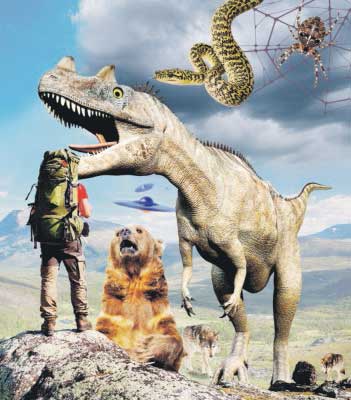RED LODGE, Mont. — Americans find ourselves in a period – arguably, the first in our nation’s history – when our unease about being in nature is coming to outweigh our desire for it. We have a growing intolerance for inconvenience, a feeling well captured by the suburban fifth-grader who memorably told nature advocate Richard Louv, “I like to play indoors better ’cause that’s where the electrical outlets are.”
Of course, adults have our own version of that. Being on the trail, in the woods or on the river for days on end brings not just thoughts of blisters and bugs and rain and heat, but perhaps more alarming, the loss of cellphone service and Facebook access.
Yet the problem runs deeper. Other symptoms include the clatter of so-called nature shows, which have become something akin to horror movies. An evening scrolling the cable guide will reveal a line-up that includes “North America’s Top 20 Most Fearsome Predators,” a rerun or two of “Shark Attack,” and a couple of episodes of “Nature’s Deadliest,” or “Rattlesnake Roundup,” or “Yukon Men.” If you’re lucky, this could be capped off by something truly catastrophic, like “Yellowstone: Brink of Disaster.” This 2013 Discovery Channel documentary, as you may have guessed, is about the super-volcano that lies in wait just under the surface of Yellowstone National Park.
Online, popular websites like BuzzFeed generate social media fodder such as “Nine Times That Nature Didn’t Care About Your Feelings.” That one offered video of a python swallowing a deer whole, and a barnacle gosling tumbling down a cliff, among others. Then, of course, there’s a whole genre of “survivalist” movies like “127 Hours,” based on the true story of a man who cut off his arm after being pinned by a rock in a Utah canyon. I sometimes feel as if the entertainment/media industry is conspiring to keep us on the sofa watching this stuff by making us afraid to go outside.
“Wild,” the movie adaptation of Cheryl Strayed’s memoir about her trek on the Pacific Crest Trail as a rite of passage through grief, stands out as a refreshing exception to this trend. Instead of portraying nature as the province of man-eating grizzlies, dangerous snakes or deadly avalanches, “Wild” reminds us how wilderness can scour the debris from a broken life. Being out in the natural world may expose us now and then to harsh conditions, but it also provides breathtaking beauty, a backdrop against which people reacquaint themselves with things that really matter.
And yet fewer people seem to seek such potentially profound experiences. Visits to the 58 crown jewels of the National Park System – nature-based parks such as Acadia, the Grand Canyon and Yosemite – peaked in 1997, and, per capita, had declined 19 percent by 2010. Some who work in state and national parks have expressed deep concern to me about how school kids show up on field trips not so much eager to play, or excited to learn, but unsettled by whatever ferocious creatures might be lurking in the bushes. As stated in a news release last summer by the U.S. Fish and Wildlife Service, “Getting (today’s) visitors to reweigh perceived threats is an art.”
Back in 1906, celebrated psychologist and educator G. Stanley Hall – the man who coined the term “adolescence” – wrote that kids age 3 to 8, especially those in the “urban hothouse,” must be exposed to nature. They should be taken “to visit field, forest, hill, shore, the water, flowers, animals, the true homes of childhood … for the very soul and body cry out for a more active, objective life, and to know nature and man at first hand. These two staples, stories and nature, by these informal methods of the home and the environment constitute fundamental education.”
A century on, however, kids are even less tutored by nature. A 2003 survey of 830 mothers by education professor Rhonda Clements revealed that 70 percent of the women said they played outdoors every day when they were kids, yet only 31 percent of their children played outside daily.
Granted, playing outside or even visiting the Grand Canyon isn’t the same as shouldering a pack and traversing mountains for weeks on end, as Cheryl Strayed did. Still, a great many men and women, if so inclined, have the physical capacity to manage such a trek. The origin of Strayed’s accomplishment isn’t her uncommon strength and endurance, but rather how she tuned into the instinct that an outer journey might foster an inner one.
Maybe it’s worth reminding ourselves that, according to the Florida Museum of Natural History, the likelihood of being attacked by a shark is about one in 3.7 million. The risk of being killed next year by a venomous snake or spider? According to the National Safety Council, about one in 95 million and one in 28 million, respectively.
Wolves, too, present only infinitesimal danger. In Idaho, which has 700 wolves, U.S. Government statistics suggest that even a cow has only a one in 21,000 chance of being killed by wolves.
As for the possibility that our fear of nature will reach the point that we lose the experience of being alive? The risk of that is harder to calculate.
Send questions/comments to the editors.


